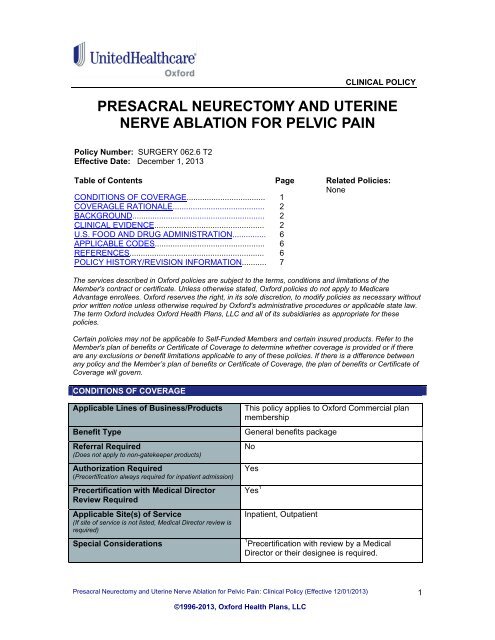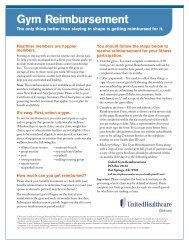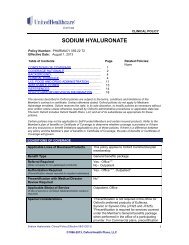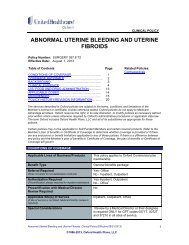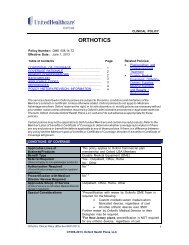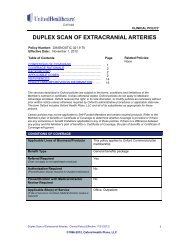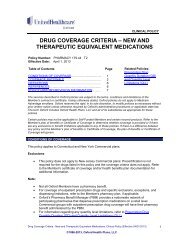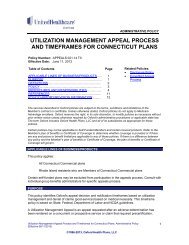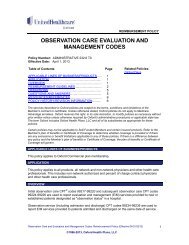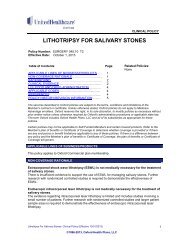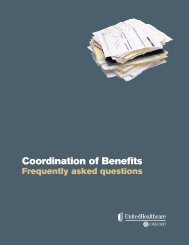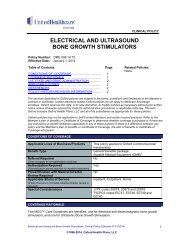Presacral Neurectomy and Uterine Nerve Ablation for Pelvic Pain
Presacral Neurectomy and Uterine Nerve Ablation for Pelvic Pain
Presacral Neurectomy and Uterine Nerve Ablation for Pelvic Pain
You also want an ePaper? Increase the reach of your titles
YUMPU automatically turns print PDFs into web optimized ePapers that Google loves.
CLINICAL POLICY<br />
PRESACRAL NEURECTOMY AND UTERINE<br />
NERVE ABLATION FOR PELVIC PAIN<br />
Policy Number: SURGERY 062.6 T2<br />
Effective Date: December 1, 2013<br />
Table of Contents<br />
CONDITIONS OF COVERAGE...................................<br />
COVERAGLE RATIONALE.........................................<br />
BACKGROUND...........................................................<br />
CLINICAL EVIDENCE.................................................<br />
U.S. FOOD AND DRUG ADMINISTRATION...............<br />
APPLICABLE CODES.................................................<br />
REFERENCES............................................................<br />
POLICY HISTORY/REVISION INFORMATION...........<br />
Page<br />
1<br />
2<br />
2<br />
2<br />
6<br />
6<br />
6<br />
7<br />
Related Policies:<br />
None<br />
The services described in Ox<strong>for</strong>d policies are subject to the terms, conditions <strong>and</strong> limitations of the<br />
Member's contract or certificate. Unless otherwise stated, Ox<strong>for</strong>d policies do not apply to Medicare<br />
Advantage enrollees. Ox<strong>for</strong>d reserves the right, in its sole discretion, to modify policies as necessary without<br />
prior written notice unless otherwise required by Ox<strong>for</strong>d's administrative procedures or applicable state law.<br />
The term Ox<strong>for</strong>d includes Ox<strong>for</strong>d Health Plans, LLC <strong>and</strong> all of its subsidiaries as appropriate <strong>for</strong> these<br />
policies.<br />
Certain policies may not be applicable to Self-Funded Members <strong>and</strong> certain insured products. Refer to the<br />
Member's plan of benefits or Certificate of Coverage to determine whether coverage is provided or if there<br />
are any exclusions or benefit limitations applicable to any of these policies. If there is a difference between<br />
any policy <strong>and</strong> the Member’s plan of benefits or Certificate of Coverage, the plan of benefits or Certificate of<br />
Coverage will govern.<br />
CONDITIONS OF COVERAGE<br />
Applicable Lines of Business/Products<br />
Benefit Type<br />
Referral Required<br />
(Does not apply to non-gatekeeper products)<br />
Authorization Required<br />
(Precertification always required <strong>for</strong> inpatient admission)<br />
Precertification with Medical Director<br />
Review Required<br />
Applicable Site(s) of Service<br />
(If site of service is not listed, Medical Director review is<br />
required)<br />
Special Considerations<br />
This policy applies to Ox<strong>for</strong>d Commercial plan<br />
membership<br />
General benefits package<br />
No<br />
Yes<br />
Yes 1<br />
Inpatient, Outpatient<br />
1 Precertification with review by a Medical<br />
Director or their designee is required.<br />
<strong>Presacral</strong> <strong>Neurectomy</strong> <strong>and</strong> <strong>Uterine</strong> <strong>Nerve</strong> <strong>Ablation</strong> <strong>for</strong> <strong>Pelvic</strong> <strong>Pain</strong>: Clinical Policy (Effective 12/01/2013)<br />
©1996-2013, Ox<strong>for</strong>d Health Plans, LLC<br />
1
COVERAGE RATIONALE<br />
<strong>Presacral</strong> neurectomy is medically necessary <strong>for</strong> treating women with primarily midline pelvic<br />
pain unresponsive to medical therapy.<br />
<strong>Presacral</strong> neurectomy is not medically necessary <strong>for</strong> treating lateral pelvic pain or symptoms<br />
other than midline pelvic pain. There is a lack of evidence that presacral neurectomy provides a<br />
clinical benefit in these patient populations.<br />
<strong>Uterine</strong> nerve ablation (UNA) <strong>and</strong> laparoscopic uterine nerve ablation (LUNA) are not<br />
medically necessary <strong>for</strong> treating chronic pelvic pain associated with dysmenorrhea or<br />
endometriosis. There is insufficient evidence in the published clinical literature establishing the<br />
effectiveness of UNA <strong>and</strong> LUNA <strong>for</strong> the treatment of dysmenorrhea. The durability of pain relief<br />
from UNA <strong>and</strong> LUNA will determine the potential beneficial effect on health outcomes. This will<br />
require well-designed clinical studies with long-term results.<br />
In<strong>for</strong>mation Pertaining to Medical Necessity Review<br />
<strong>Presacral</strong> neurectomy may be considered as an alternative to hysterectomy <strong>for</strong> endometriosis<br />
with refractory dysmenorrhea involving midline pelvic pain when either of the following criteria has<br />
been met:<br />
• A 3-month trial of oral contraceptives has been tried OR<br />
• If oral contraceptives are contraindicated, menstrual suppression with progesterone or<br />
gonadotropin-releasing hormone (GnRH) agonist therapy has been tried instead.<br />
BACKGROUND<br />
Chronic pelvic pain (CPP) is defined as nonmenstrual pelvic pain lasting <strong>for</strong> 6 months or more<br />
(American College of Obstetricians <strong>and</strong> Gynecologists, 2004). CPP includes primary <strong>and</strong><br />
secondary dysmenorrhea, chronic painful conditions of the pelvis that occur during menstruation.<br />
Primary dysmenorrhea refers to pain without a known cause. Secondary dysmenorrhea refers to<br />
pain associated with a physical cause such as endometriosis or pelvic adhesions. Treatments <strong>for</strong><br />
primary dysmenorrhea are aimed at providing relief of symptoms <strong>and</strong> include over-the-counter<br />
(OTC) <strong>and</strong> prescription pain relief medications <strong>and</strong> oral contraceptives.<br />
<strong>Presacral</strong> neurectomy <strong>and</strong> uterine nerve ablation are two surgical procedures that are used <strong>for</strong><br />
individuals who do not respond to medication <strong>and</strong> who continue to suffer from severe primary<br />
dysmenorrhea. <strong>Presacral</strong> neurectomy interrupts the sympathetic nerves of the uterus near the<br />
superior hypogastric plexus. Laparoscopic uterine nerve ablation (LUNA) destroys uterine nerve<br />
fibers as they leave the uterus via the uterosacral ligaments (ECRI, 2011).<br />
CLINICAL EVIDENCE<br />
An Agency <strong>for</strong> Healthcare Research <strong>and</strong> Quality (AHRQ) comparative effectiveness report on<br />
therapies <strong>for</strong> noncyclic chronic pelvic pain (CPP) concluded that no surgical technique was<br />
superior, <strong>and</strong> the evidence to conclude that surgical intervention is either effective or ineffective<br />
<strong>for</strong> the treatment of CPP is insufficient. Among studies addressing treatment effects, little<br />
evidence demonstrates the effectiveness of surgical approaches. Despite numerous surgical<br />
techniques used extensively in treating CPP, few studies included more than 50 participants, <strong>and</strong><br />
few were considered high quality. All of the studies with comparison data failed to demonstrate<br />
that surgery in general or any specific surgical technique was more efficacious than either<br />
nonsurgical intervention or the comparator technique in improving pain status in patients<br />
(Andrews et al., 2012).<br />
In a systematic review of seven Cochrane review articles <strong>and</strong> 35 r<strong>and</strong>omized trials evaluating<br />
laparoscopic management of endometriosis, Yeung et al. (2009) concluded that laparoscopic<br />
<strong>Presacral</strong> <strong>Neurectomy</strong> <strong>and</strong> <strong>Uterine</strong> <strong>Nerve</strong> <strong>Ablation</strong> <strong>for</strong> <strong>Pelvic</strong> <strong>Pain</strong>: Clinical Policy (Effective 12/01/2013)<br />
©1996-2013, Ox<strong>for</strong>d Health Plans, LLC<br />
2
presacral neurectomy, but not laparoscopic uterosacral nerve ablation, is a useful adjunct to<br />
conservative surgery <strong>for</strong> endometriosis in patients with a midline component of pain.<br />
Latthe et al. (2007) conducted a systematic review of nine r<strong>and</strong>omized controlled trials to assess<br />
the effectiveness of surgical interruption of the pelvic nerve pathways in primary <strong>and</strong> secondary<br />
dysmenorrhea. At 12 month follow-up, the authors found that <strong>for</strong> the treatment of primary<br />
dysmenorrhea, laparoscopic uterosacral nerve ablation (LUNA) was more effective when<br />
compared to no treatment. However, the comparison of LUNA with presacral neurectomy (PSN)<br />
<strong>for</strong> primary dysmenorrhea showed that PSN was more effective. In secondary dysmenorrhea,<br />
LUNA along with laparoscopic surgical treatment of endometriosis showed no improvement in<br />
pain relief while presacral neurectomy did. The authors concluded that while presacral<br />
neurectomy appears effective, evidence <strong>for</strong> nerve interruption procedures in the management of<br />
dysmenorrhea is limited; additional methodologically sound <strong>and</strong> sufficiently powered RCTs are<br />
needed.<br />
In a systematic review, Cheong <strong>and</strong> William (2006) examined the current evidence on the<br />
etiology <strong>and</strong> management of chronic pelvic pain, focusing on the r<strong>and</strong>omized controlled trials<br />
(RCTs) that are available to date. According to the reviewers, the short term results <strong>for</strong> presacral<br />
neurectomy (PSN) <strong>and</strong> laparoscopic utero-sacral nerve ablation (LUNA) seemed to be similar,<br />
although PSN has better results in the long term.<br />
Proctor et al. (2005) conducted a Cochrane meta-analysis of eight r<strong>and</strong>omized controlled trials<br />
comparing surgical techniques of interruption of the pelvic nerve pathways (using both open <strong>and</strong><br />
laparoscopic procedures) <strong>for</strong> the treatment of primary <strong>and</strong> secondary dysmenorrhea. For the<br />
treatment of primary dysmenorrhea there was some evidence of the effectiveness of laparoscopic<br />
uterine nerve ablation (LUNA) when compared to a control or no treatment. The comparison<br />
between LUNA <strong>and</strong> laparoscopic presacral neurectomy (LPSN) <strong>for</strong> primary dysmenorrhea<br />
showed no significant difference in pain relief in the short term; however, long-term LPSN was<br />
shown to be significantly more effective than LUNA. For the treatment of secondary<br />
dysmenorrhea six identified RCTs addressed endometriosis <strong>and</strong> one included women with<br />
uterine myomas. The treatment of LUNA combined with surgical treatment of endometrial<br />
implants versus surgical treatment of endometriosis alone showed that the addition of LUNA did<br />
not aid pain relief. For PSN combined with endometriosis treatment versus endometriosis<br />
treatment alone there was an overall difference in pain relief although the data suggests this may<br />
be specific to laparoscopy <strong>and</strong> <strong>for</strong> midline abdominal pain only. Adverse events were significantly<br />
more common <strong>for</strong> presacral neurectomy; however, the majority were complications such as<br />
constipation, which may spontaneously improve. The authors concluded that there is insufficient<br />
evidence to recommend the use of nerve interruption in the management of dysmenorrhoea,<br />
regardless of cause. Future methodologically sound <strong>and</strong> sufficiently powered RCTs should be<br />
undertaken.<br />
<strong>Presacral</strong> <strong>Neurectomy</strong><br />
Zullo et al. (2003) completed 2 r<strong>and</strong>omized controlled trials to study the effectiveness of presacral<br />
neurectomy (PSN) in women with severe dysmenorrhea caused by endometriosis. The initial<br />
study involved 141 patients who were r<strong>and</strong>omly assigned to either receive presacral neurectomy<br />
(71 patients) or not (70 patients). Patients were followed <strong>for</strong> 1 year. Patients receiving presacral<br />
neurectomy (PSN) had greater relief of symptoms than the non-PSN group. The second study,<br />
conducted at 24 months, reviewed response rate to PSN in 126 of the available 141 patients<br />
(Zullo, 2004). Six patients were excluded from follow-up due to additional surgery <strong>for</strong> recurrent<br />
endometriosis. At follow-up, 83.3% of the patients receiving PSN compared to 53.3% who did not<br />
showed complete relief of symptoms. Although PSN appeared to be more effective than surgery<br />
alone <strong>for</strong> the relief of endometriosis-associated pain, it resulted in a higher number of long-term<br />
complications, such as constipation (14%) <strong>and</strong> urinary urgency (5%); no long-term complications<br />
were observed in the patients who did not have PSN at the time of surgery.<br />
C<strong>and</strong>iani et al. (1992) conducted a r<strong>and</strong>omized, controlled trial of 71 patients to assess the<br />
efficacy of presacral neurectomy (PSN) combined with conservative surgery to treat pelvic pain<br />
associated with moderate to severe endometriosis <strong>and</strong> midline dysmenorrhea. Patients were<br />
<strong>Presacral</strong> <strong>Neurectomy</strong> <strong>and</strong> <strong>Uterine</strong> <strong>Nerve</strong> <strong>Ablation</strong> <strong>for</strong> <strong>Pelvic</strong> <strong>Pain</strong>: Clinical Policy (Effective 12/01/2013)<br />
©1996-2013, Ox<strong>for</strong>d Health Plans, LLC<br />
3
<strong>and</strong>omly assigned to conservative surgery alone (36 patients) or conservative surgery <strong>and</strong><br />
presacral neurectomy (35 patients). The results showed that while more PSN-treated patients<br />
were free of midline dysmenorrhea at 1 year compared with those who had laparotomy alone, the<br />
difference was not significant (66% versus 58%, respectively). There were no differences<br />
between the PSN <strong>and</strong> non-PSN groups with respect to improvement in or resolution of<br />
dyspareunia (84% <strong>and</strong> 67%, respectively) <strong>and</strong> intermenstrual pelvic pain (82% <strong>and</strong> 80%,<br />
respectively). The strengths of this study were its r<strong>and</strong>omized, controlled trial design; defined pain<br />
measures; <strong>and</strong> power analysis to determine required sample size. Major weaknesses were lack<br />
of blinding <strong>and</strong> the fact that pain measures did not discriminate between midline <strong>and</strong> lateral pain.<br />
A large retrospective analysis with 1 year of follow-up evaluated the efficacy <strong>and</strong> safety of<br />
laparoscopic presacral neurectomy (PSN) with ablation of endometriosis lesions or lysis of pelvic<br />
adhesions if needed in 655 patients with severe, disabling dysmenorrhea or CPP refractory to<br />
medical therapy (Chen, 1997). Of these, 390 patients had secondary dysmenorrhea related to<br />
endometriosis or adenomyosis, 99 had primary dysmenorrhea, <strong>and</strong> 166 had CPP. Laparoscopic<br />
PSN was efficacious <strong>for</strong> controlling pain in 73% <strong>and</strong> 75% of patients with moderate-to-severe <strong>and</strong><br />
mild endometriosis, respectively, 77% of patients with primary dysmenorrhea, <strong>and</strong> 52% of<br />
patients with adenomyosis. The reduction in pain was significant <strong>for</strong> all groups (P=0.006). There<br />
were four major complications (0.6%) that required further surgery including injury of the right iliac<br />
artery (n = 1), <strong>and</strong> chylous ascites (n = 3). Three patients (0.5%) had laceration of the middle<br />
sacral vein during laparoscopy. A total of 485 (74%) patients had constipation that was controlled<br />
with medication.<br />
<strong>Uterine</strong> <strong>Nerve</strong> <strong>Ablation</strong><br />
El-Din Shawki (2011) explored the efficacy, safety <strong>and</strong> patient satisfaction of laparoscopic<br />
uterosacral nerve ablation (LUNA) in the relief of chronic pelvic pain in women with no pathology<br />
or mild endometriosis. The study was a prospective, single-blind, r<strong>and</strong>omized trial with 12 months<br />
follow-up. One hundred ninety women were r<strong>and</strong>omized <strong>and</strong> divided into two equal groups. The<br />
control group had diagnostic laparoscopy with no pelvic denervation while the study group had<br />
diagnostic laparoscopy plus LUNA. At 3, 6, <strong>and</strong> 12 months follow-up, there was no statistically<br />
significant difference between groups <strong>for</strong> efficacy, overall success rate <strong>and</strong> patient satisfaction.<br />
Using individual patient data (IPD), the International LUNA IPD Meta-analysis Collaborative<br />
Group evaluated the effects of laparoscopic uterosacral nerve ablation (LUNA) on chronic pelvic<br />
pain. R<strong>and</strong>omized trials comparing LUNA with no additional intervention were selected <strong>and</strong><br />
authors contacted <strong>for</strong> IPD. Raw data were available from 862 women r<strong>and</strong>omized into five trials.<br />
The authors found no significant difference between the treatment groups <strong>and</strong> concluded that<br />
LUNA does not result in improved chronic pelvic pain (Daniels, 2010).<br />
Daniels et al. (2009) assessed the effectiveness of laparoscopic uterosacral nerve ablation<br />
(LUNA) in 487 women with chronic pelvic pain. Participants were r<strong>and</strong>omized to receive bilateral<br />
LUNA (n=243) or laparoscopy without pelvic denervation (no LUNA) (n=244) <strong>and</strong> were blinded to<br />
the treatment allocation. Follow-up questionnaires were sent to the women at 3 <strong>and</strong> 6 months <strong>and</strong><br />
at 1, 2, 3, <strong>and</strong> 5 years. The primary outcome was pain, which was assessed by a visual analogue<br />
scale. The secondary outcome was health-related quality of life, which was measured using a<br />
generic instrument (EuroQoL EQ-5D <strong>and</strong> EQ-VAS). After a median follow-up of 69 months, there<br />
were no significant differences reported on the pain scales between the two groups. No<br />
differences were observed between the LUNA group <strong>and</strong> the no LUNA group <strong>for</strong> quality of life.<br />
Among women with chronic pelvic pain, LUNA did not result in improvements in pain,<br />
dysmenorrhea, dyspareunia or quality of life compared with laparoscopy without pelvic<br />
denervation.<br />
In a r<strong>and</strong>omized controlled trial, 180 women underwent laparoscopic resection of the uterosacral<br />
ligaments to treat endometriosis <strong>and</strong> predominantly midline dysmenorrhea. Among the patients<br />
who were evaluable 1 year after operative laparoscopy, 23 of 78 (29%) women who had<br />
uterosacral ligament resection <strong>and</strong> 21 of 78 (27%) women who had conservative surgery only<br />
reported recurrent dysmenorrhea. The corresponding numbers of patients at 3 years were 21 of<br />
59 (36%) women <strong>and</strong> 18 of 57 (32%) women, respectively. Time to recurrence was similar in the<br />
<strong>Presacral</strong> <strong>Neurectomy</strong> <strong>and</strong> <strong>Uterine</strong> <strong>Nerve</strong> <strong>Ablation</strong> <strong>for</strong> <strong>Pelvic</strong> <strong>Pain</strong>: Clinical Policy (Effective 12/01/2013)<br />
©1996-2013, Ox<strong>for</strong>d Health Plans, LLC<br />
4
two groups. <strong>Pain</strong> was substantially reduced, <strong>and</strong> patients in both groups experienced similar <strong>and</strong><br />
significant improvements in health-related quality of life, psychiatric profile <strong>and</strong> sexual<br />
satisfaction. Overall, 68 of 90 (75%) patients in the uterosacral ligament resection group <strong>and</strong> 67<br />
of 90 (74%) patients in the conservative surgery group were satisfied at 1 year. Addition of<br />
uterosacral ligament resection to conservative laparoscopic surgery <strong>for</strong> endometriosis did not<br />
reduce the medium- or long-term frequency <strong>and</strong> severity of recurrence of dysmenorrhea<br />
(Vercellini, 2003).<br />
Johnson et al. (2004) conducted a prospective, double-blind, r<strong>and</strong>omized controlled trial with 123<br />
women to determine the effectiveness of laparoscopic uterine nerve ablation (LUNA) <strong>for</strong> chronic<br />
pelvic pain (CPP). Women were r<strong>and</strong>omized into two groups: those with endometriosis (n=67),<br />
<strong>and</strong> those with no laparoscopic evidence of endometriosis (n=56), to receive LUNA or no LUNA.<br />
Patients were followed <strong>for</strong> 12 months. The primary outcome measures were changes in nonmenstrual<br />
pelvic pain, dysmenorrhea, deep dyspareunia <strong>and</strong> excessive straining with bowel<br />
movements as measured by visual analogue scores (VAS). There was a significant reduction in<br />
dysmenorrhea in women with CPP without endometriosis who underwent LUNA (p=0.039). There<br />
was no significant difference in non-menstrual pelvic pain, deep dyspareunia or excessive<br />
straining with bowel movements in women without endometriosis undergoing LUNA versus no<br />
LUNA. The addition of LUNA to laparoscopic surgical treatment of endometriosis was not<br />
associated with a significant difference in any pain outcomes. It was concluded that LUNA is<br />
effective <strong>for</strong> dysmenorrhea in the absence of endometriosis, although there is no evidence of<br />
effectiveness of LUNA <strong>for</strong> non-dysmenorrhea CPP or <strong>for</strong> any type of CPP related to<br />
endometriosis.<br />
Palomba et al. (2006) compared laparoscopic uterine nerve ablation (LUNA) <strong>and</strong> vaginal<br />
uterosacral ligament resection (VUSR) in postmenopausal women with chronic pelvic pain (CPP).<br />
Eighty postmenopausal women with intractable <strong>and</strong> severe midline CPP were r<strong>and</strong>omized to<br />
undergo LUNA or VUSR. Cure rate, severity of CPP, <strong>and</strong> deep dyspareunia were evaluated after<br />
6 <strong>and</strong> 12 months from surgery. The cure rate was not significantly different between the two<br />
groups at 6 months <strong>and</strong> 12 months of follow-up. A significant decrease in severity of CPP <strong>and</strong><br />
deep dyspareunia was observed in both groups with no difference between them. The<br />
investigators concluded that both LUNA <strong>and</strong> VUSR are equally effective surgical treatments in<br />
postmenopausal women with central CPP.<br />
The National Institute <strong>for</strong> Health <strong>and</strong> Care Excellence (NICE) issued a guidance document<br />
concerning LUNA <strong>for</strong> chronic pelvic pain in 2007. According to NICE, the evidence on LUNA <strong>for</strong><br />
chronic pelvic pain suggests that LUNA is not efficacious <strong>and</strong> there<strong>for</strong>e should not be used. This<br />
conclusion was based on an evaluation of nine RCTs including 528 women treated with LUNA<br />
(NICE, 2007).<br />
The clinical evidence was reviewed on July 24, 2013 with no additional in<strong>for</strong>mation identified that<br />
would change the policy conclusions.<br />
Professional Societies<br />
American College of Obstetricians <strong>and</strong> Gynecologists (ACOG)<br />
An ACOG practice bulletin on chronic pelvic pain recommends that presacral neurectomy may be<br />
considered <strong>for</strong> treatment of centrally located dysmenorrhea but has limited efficacy <strong>for</strong> chronic<br />
pelvic pain or pain that is not central in its location. <strong>Uterine</strong> nerve ablation or transection of the<br />
uterosacral ligament also can be considered <strong>for</strong> centrally located dysmenorrheal, but it appears to<br />
be less effective than presacral neurectomy. Combining uterine nerve ablation or presacral<br />
neurectomy with surgical treatment of endometriosis does not further improve overall pain relief<br />
(ACOG, 2004; reaffirmed 2010).<br />
American Society <strong>for</strong> Reproductive Medicine (ASRM)<br />
In an educational bulletin on the treatment of pelvic pain associated with endometriosis, ASRM<br />
states the following:<br />
<strong>Presacral</strong> <strong>Neurectomy</strong> <strong>and</strong> <strong>Uterine</strong> <strong>Nerve</strong> <strong>Ablation</strong> <strong>for</strong> <strong>Pelvic</strong> <strong>Pain</strong>: Clinical Policy (Effective 12/01/2013)<br />
©1996-2013, Ox<strong>for</strong>d Health Plans, LLC<br />
5
• <strong>Presacral</strong> neurectomy has been proposed <strong>for</strong> treatment of midline pain associated with<br />
menses, because its effects on other components of pelvic pain have been inconsistent.<br />
However, it is important to recognize that presacral neurectomy is a technically<br />
challenging procedure associated with significant risk of bleeding.<br />
• LUNA does not appear to offer any added benefits beyond those that can be achieved<br />
with conservative surgery alone (ASRM, 2008).<br />
U.S. FOOD AND DRUG ADMINISTRATION<br />
<strong>Presacral</strong> neurectomy (PSN) <strong>and</strong> uterine nerve ablation are surgical procedures, <strong>and</strong> there<strong>for</strong>e,<br />
are not subject to regulation by the FDA.<br />
The laparoscopic equipment used in laparoscopic uterine nerve ablation (LUNA) is organized by<br />
the FDA into a number of product codes, all of which receive 510(k) clearance <strong>for</strong> marketing.<br />
These codes are not specific <strong>for</strong> LUNA, <strong>and</strong> the FDA database does not provide a single list of<br />
devices cleared specifically <strong>for</strong> LUNA.<br />
APPLICABLE CODES<br />
The codes listed in this policy are <strong>for</strong> reference purposes only. Listing of a service or device code<br />
in this policy does not imply that the service described by this code is a covered or non-covered<br />
health service. Coverage is determined by the Member’s plan of benefits or Certificate of<br />
Coverage. This list of codes may not be all inclusive.<br />
Applicable CPT Codes<br />
CPT ® Code<br />
Description<br />
58578 Unlisted laparoscopy procedure, uterus<br />
58999 Unlisted procedure, female genital system (nonobstetrical)<br />
64999 Unlisted procedure, nervous system<br />
CPT ® is a registered trademark of the American Medical Association.<br />
REFERENCES<br />
The <strong>for</strong>egoing Ox<strong>for</strong>d policy has been adapted from an existing UnitedHealthcare national policy<br />
that was researched, developed <strong>and</strong> approved by the UnitedHealthcare Medical Technology<br />
Assessment Committee. [2013T0059J]<br />
American College of Obstetricians <strong>and</strong> Gynecologists (ACOG). ACOG Practice Bulletin No. 51.<br />
Chronic pelvic pain. Obstet Gynecol. 2004;103(3):589-605. Reaffirmed 2010.<br />
American Society <strong>for</strong> Reproductive Medicine (ASRM) Educational Bulletin. Treatment of pelvic<br />
pain associated with endometriosis. Fertil Steril. 2008 Nov;90(5 Suppl):S260-9. Available at:<br />
http://www.asrm.org/uploadedFiles/ASRM_Content/News_<strong>and</strong>_Publications/Practice_Guidelines/<br />
Educational_Bulletins/Treatment_of_pelvic_pain(1).pdf. Accessed July 24, 2013.<br />
Andrews J, Yunker A, Reynolds WS, et al. Noncyclic chronic pelvic pain therapies <strong>for</strong> women:<br />
comparative effectiveness. Rockville (MD): Agency <strong>for</strong> Healthcare Research <strong>and</strong> Quality (US);<br />
2012 Jan. Available at: http://www.ncbi.nlm.nih.gov/books/NBK84586/. Accessed July 24, 2013.<br />
C<strong>and</strong>iani GB, Fedele L, Vercellini P, et al. <strong>Presacral</strong> neurectomy <strong>for</strong> the treatment of pelvic pain<br />
associated with endometriosis: a controlled study. Am J Obstet Gynecol. 1992;167(1):100-103.<br />
Chen FP, Soong YK. The efficacy <strong>and</strong> complications of laparoscopic presacral neurectomy in<br />
pelvic pain. Obstet Gynecol. 1997;90(6):974-977.<br />
Cheong Y, William SR. Chronic pelvic pain: aetiology <strong>and</strong> therapy. Best Pract Res Clin Obstet<br />
Gynaecol. 2006;20(5):695-711.<br />
<strong>Presacral</strong> <strong>Neurectomy</strong> <strong>and</strong> <strong>Uterine</strong> <strong>Nerve</strong> <strong>Ablation</strong> <strong>for</strong> <strong>Pelvic</strong> <strong>Pain</strong>: Clinical Policy (Effective 12/01/2013)<br />
©1996-2013, Ox<strong>for</strong>d Health Plans, LLC<br />
6
Daniels J, Gray R, Hills RK, et al. LUNA Trial Collaboration. Laparoscopic uterosacral nerve<br />
ablation <strong>for</strong> alleviating chronic pelvic pain: a r<strong>and</strong>omized controlled trial. JAMA. 2009 Sep<br />
2;302(9):955-61.<br />
Daniels JP, Middleton L, Xiong T, International LUNA IPD Meta-analysis Collaborative Group et<br />
al. Individual patient data meta-analysis of r<strong>and</strong>omized evidence to assess the effectiveness of<br />
laparoscopic uterosacral nerve ablation in chronic pelvic pain. Hum Reprod Update. 2010 Nov-<br />
Dec;16(6):568-76.<br />
ECRI Institute. Hotline Service. Laparoscopic uterosacral nerve ablation <strong>for</strong> dysmenorrhea. May<br />
2011.<br />
El-Din Shawki H. The efficacy of laparoscopic uterosacral nerve ablation (LUNA) in the treatment<br />
of unexplained chronic pelvic pain: a r<strong>and</strong>omized controlled trial. Gynecol Surg. 2011<br />
Feb;8(1):31-39.<br />
Johnson NP, Farquhar CM, Crossley S, et al. A double-blind r<strong>and</strong>omised controlled trial of<br />
laparoscopic uterine nerve ablation <strong>for</strong> women with chronic pelvic pain. BJOG. 2004<br />
Sep;111(9):950-9.<br />
Latthe PM, Proctor ML, Farquhar CM, et al. Surgical interruption of pelvic nerve pathways in<br />
dysmenorrhea: a systematic review of effectiveness. Acta Obstet Gynecol Sc<strong>and</strong>. 2007;86(1):4-15.<br />
National Institute <strong>for</strong> Health <strong>and</strong> Care Excellence (NICE). Laparoscopic uterine nerve ablation<br />
(LUNA) <strong>for</strong> chronic pelvic pain. IPG234. October 2007. Available at:<br />
http://www.nice.org.uk/nicemedia/pdf/IPG234Guidance.pdf. Accessed July 24, 2013<br />
Palomba S, Russo T, Falbo A, et al. Laparoscopic uterine nerve ablation versus vaginal<br />
uterosacral ligament resection in postmenopausal women with intractable midline chronic pelvic<br />
pain: a r<strong>and</strong>omized study. Eur J Obstet Gynecol Reprod Biol. 2006;129(1):84-91.<br />
Proctor M, Latthe P, Farquhar CM, et al. Surgical interruption of pelvic nerve pathways <strong>for</strong><br />
primary <strong>and</strong> secondary dysmenorrhoea. Cochrane Database of Systematic Reviews 2005, Issue<br />
4. Art. No.: CD001896.<br />
Vercellini P, Aimi G, Busacca M, et al. Laparoscopic uterosacral ligament resection <strong>for</strong><br />
dysmenorrhea associated with endometriosis: results of a r<strong>and</strong>omized, controlled trial. Fertil<br />
Steril. 2003 Aug;80(2):310-9.<br />
Yeung PP Jr, Shwayder J, Pasic RP. Laparoscopic management of endometriosis:<br />
comprehensive review of best evidence. J Minim Invasive Gynecol. 2009 May-Jun;16(3):269-81.<br />
Zullo F, Palomba S, Zupi E, et al. Effectiveness of presacral neurectomy in women with severe<br />
dysmenorrhea caused by endometriosis who were treated with laparoscopic conservative<br />
surgery: a 1-year prospective r<strong>and</strong>omized double-blind controlled trial. Am J Obstet Gynecol.<br />
2003;189(1):5-10.<br />
Zullo F, Palomba S, Zupi E, et al. Long-term effectiveness of presacral neurectomy <strong>for</strong> the<br />
treatment of severe dysmenorrhea due to endometriosis. J Am Assoc Gynecol Laparosc.<br />
2004;11(1):23-28.<br />
POLICY HISTORY/REVISION INFORMATION<br />
Date<br />
12/01/2013<br />
Action/Description<br />
• Updated description of services to reflect most current clinical<br />
evidence, FDA in<strong>for</strong>mation <strong>and</strong> references<br />
<strong>Presacral</strong> <strong>Neurectomy</strong> <strong>and</strong> <strong>Uterine</strong> <strong>Nerve</strong> <strong>Ablation</strong> <strong>for</strong> <strong>Pelvic</strong> <strong>Pain</strong>: Clinical Policy (Effective 12/01/2013)<br />
©1996-2013, Ox<strong>for</strong>d Health Plans, LLC<br />
7
• Reworded/re<strong>for</strong>matted coverage rationale; added in<strong>for</strong>mation<br />
pertaining to medical necessity review<br />
• Updated list of applicable HCPCS codes; removed C1886<br />
• Removed list of applicable ICD-9 <strong>and</strong> ICD-10 diagnosis codes<br />
(previously included <strong>for</strong> in<strong>for</strong>mational purposes only)<br />
• Archived previous policy version SURGERY 062.5 T2<br />
<strong>Presacral</strong> <strong>Neurectomy</strong> <strong>and</strong> <strong>Uterine</strong> <strong>Nerve</strong> <strong>Ablation</strong> <strong>for</strong> <strong>Pelvic</strong> <strong>Pain</strong>: Clinical Policy (Effective 12/01/2013)<br />
©1996-2013, Ox<strong>for</strong>d Health Plans, LLC<br />
8


